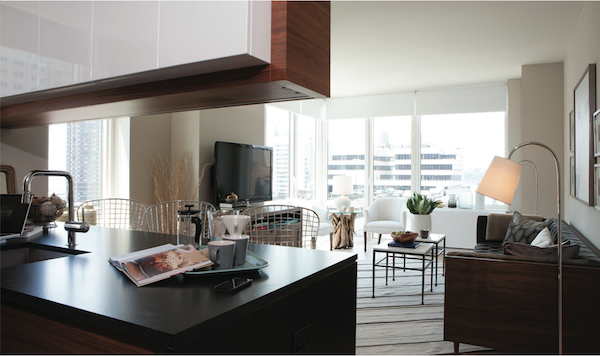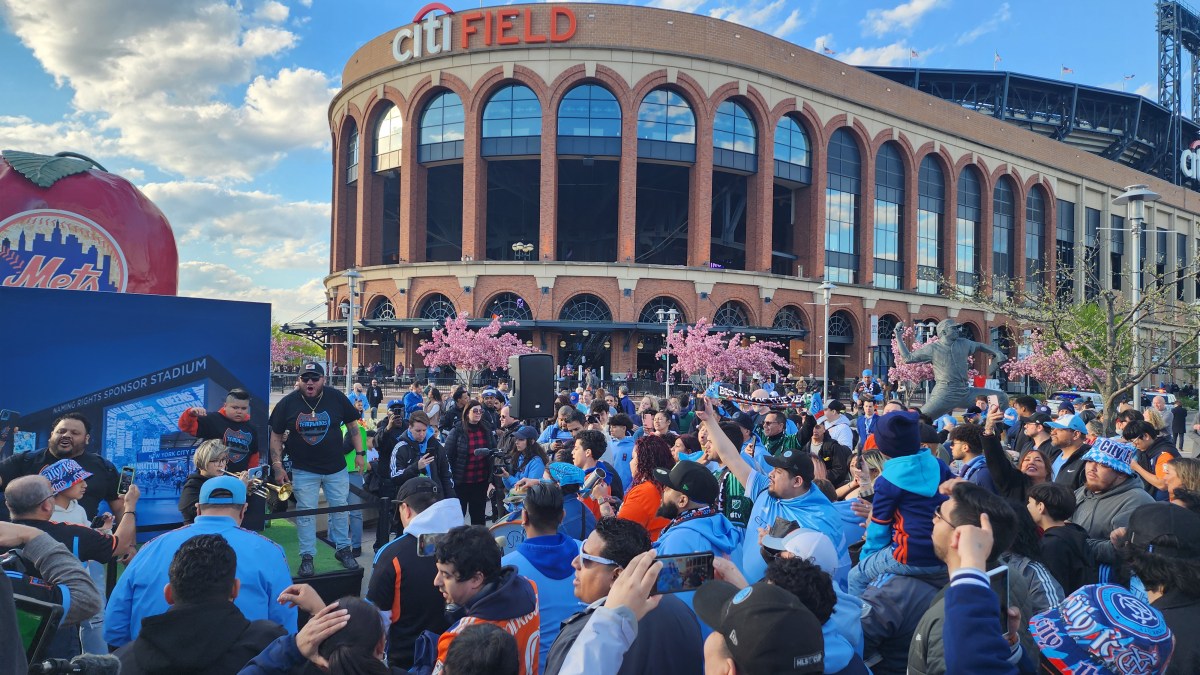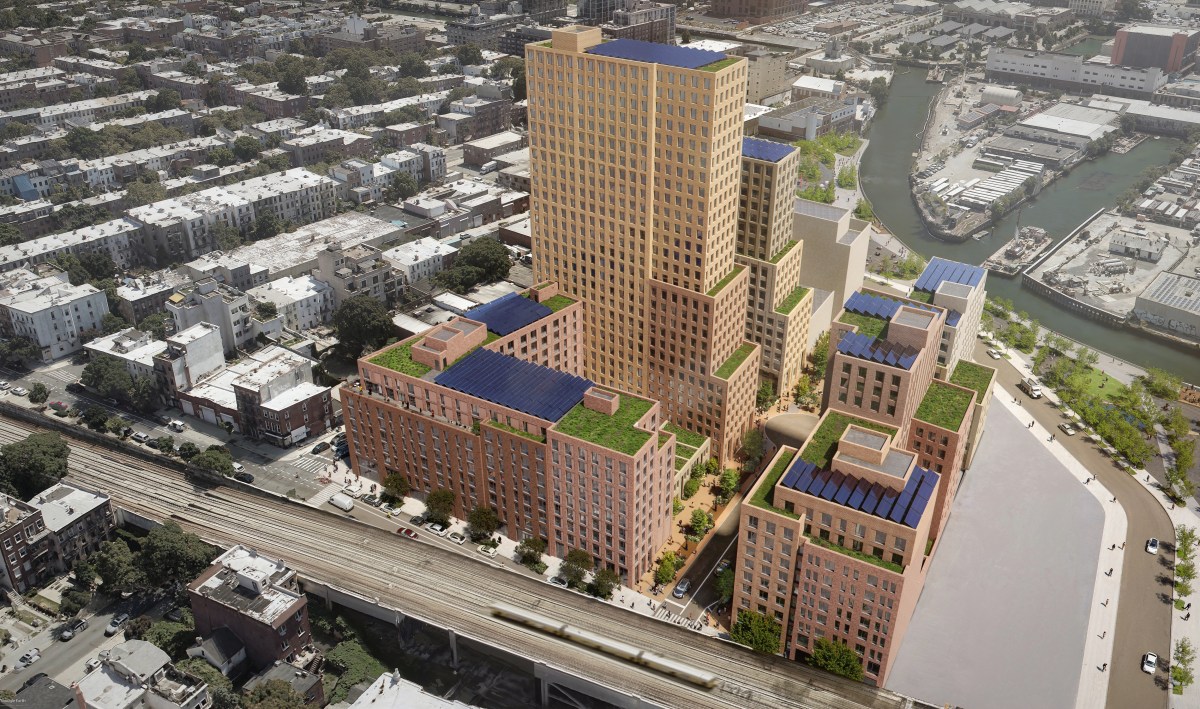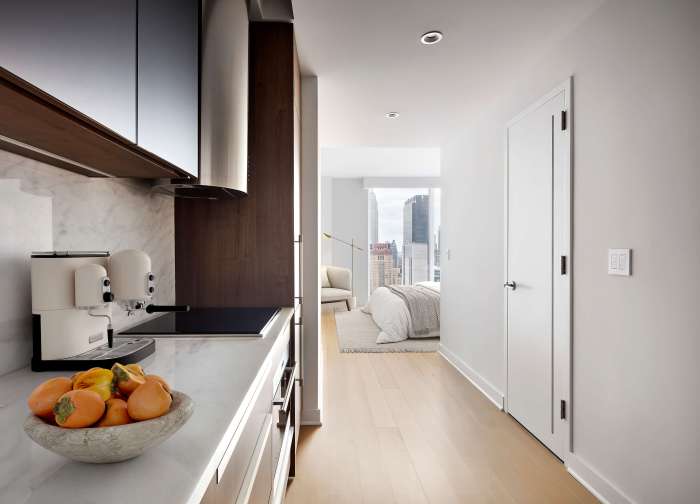
Gotham West on West 45th St., above and at bottom.
BY LAUREN PRICE | “Our city’s biggest challenge is the growing disparity between affordable and market-rate housing,” according to Jonathan Miller, the president and C.E.O. of Miller Samuel Inc., a New York-based real estate appraisal and consulting firm. “Producing affordable housing helps us provide a greater diversity for labor skills needed in New York. And in the long run, affordable housing stands as an essential component for the city to continue as a thriving community.”
Mayor Bill de Blasio, whose 2013 campaign focused considerable attention on expanding affordable housing opportunities, laid out the specifics of his plan earlier this month. A report released by City Comptroller Scott Stringer in April made clear the scope of the housing affordability challenge facing the city after 12 years in which median apartment rents grew by 75 percent, compared to an average increase nationwide of 44 percent.
De Blasio’s goal of building or preserving 200,000 units of affordable housing over the next decade represents a significant step up from the 165,000-unit record from the 12 years of the Bloomberg administration.
The new mayor comes to his mission with considerable housing qualifications. During the Clinton administration, he served as the regional director for the U.S. Dept. of Housing and Urban Development under then-Secretary Andrew Cuomo. As a member of the City Council prior to his election as public advocate in 2009, de Blasio wrote the law that stopped landlords from discriminating against tenants based on their source of income.
Currently, developers of rental properties can receive low-cost financing through the city’s Housing Finance Agency when at least 20 percent of the units are designated as affordable housing. Drawing on funds raised through the sale of tax-exempt bonds, the H.F.A. requires that qualifying apartments must be affordable and rented to households with incomes at or below 50 percent of the neighborhood Area Median Income, adjusted for family size. An alternative way for developers to qualify is to set aside 25 percent or more of a project’s units for households whose income is 60 percent or less than the local A.M.I., adjusted for family size.
Affordability is defined as a monthly rent no greater than 30 percent of gross household income.
A list of projects financed by H.F.A. currently holding lotteries or accepting applications can be found at nyshcr.org/topics/home/renters/opportunitiestoapplyforaffordablerentalunits.htm.
New York’s is a high-density housing market short on land, but more than a few of New York’s major development companies are big players in “80/ 20” affordable housing programs.

Related Companies, one of the nation’s largest developers, has a significant commitment to developing, acquiring, and preserving housing in the affordable sector. In fact, according to the company’s website, more than 60 percent of its 50,000-plus apartments under management are part of one or more affordable housing programs (related.com/our-company/businesses/9/affordable-housing).
L+M Development Partners is a builder of affordable, mixed-income, and market rate housing. From conception to completion, this developer is responsible for more than $2.5 billion in housing development, investment, and construction, having created more than 15,000 units in the tri-state area.
In a partnership with Dunn Development, L + M is currently developing the mixed-use, multi-building Navy Green complex on Clermont and Vanderbilt Aves. in Fort Greene near the Brooklyn Navy Yard. Offering about 460 units when completed, the development represents a combination of rentals and condos, with more than 20 percent of the total designated as affordable, as well as nearly 100 units of supportive housing. (lmdevpartners.com)
TF Cornerstone focuses on acquisition, development, construction, and management of residential, commercial, and retail properties. With an aggressive acquisition strategy and a construction division, the company’s property portfolio includes a collection of luxury residential buildings.
Partnering with Selfhelp, a senior citizen non-profit organization, the company is now at work on Phase II at Hunters Point South, which is a massive housing complex along the Long Island City riverfront. Made up of two high-rise towers with nearly 1,200 units, the development is setting aside 60 percent for affordable housing — with some 100 units reserved for seniors. The development will feature a fitness center, a rock-climbing wall, a rooftop deck, a pre-K school, and a dedicated senior recreational center with fitness classes, nutritional education, and blood pressure testing, among other services. (tfcornerstone.com/new-york-city-life/tag/affordable-housing/)
Gotham West, located in a series of buildings on West 45th St., is a mixed-use, 1,238-unit development from the Gotham Organization (gothamorganization.com). There are 250 units that fall into the 80/20 program, and the development has created another 432 units for middle-income housing.
“Gotham West is currently accepting applications for the middle-income category,” said Melissa Pianko, Gotham’s executive vice president of development. “We also have another 80/ 20 project under construction at 600 Fulton St. in Brooklyn, but marketing efforts have yet to begin.”

















